2 中国科学院广州地球化学研究所, 中国科学院边缘海与大洋地质重点实验室, 广东 广州 510640;
3 广州海洋地质调查局, 广东 广州 510075)
Heinrich事件,是北半球急速变冷的千年尺度气候事件[1~2]。Heinrich[1]最早发现北大西洋沉积物在70~14 ka B. P.期间出现过多次间断性的混杂堆积物,并认为它们可能是北美和格陵兰冰盖的浮冰带来的。这种快速变冷的浮冰事件前后共发现6期,每期持续时间为1~2 ka,统称为Heinrich事件(以下简称“H事件”)。后来的研究证实,H事件也发生在中、低纬度地区也有记录,如北美[3]、我国的黄土高原[4~5]、西北干旱区[6]、华南[7~8]等地。然而,H事件在太平洋及周边不同地区的响应存在差异,且有关H事件的驱动机制还存在争议[9]。因此,需要通过更多的地质记录,来探讨H事件的影响范围和成因。
南海位于亚洲季风区,沉积物因具有较高的沉积速率而被广泛用于记录亚洲季风的演化历史[10~11]。前人在南海东北部陆坡[12]、珠江口[13]、南部陆坡[14~15]等地识别出H事件,而对南海西北部气候演变的研究仅限于全新世[16]。南海西北部及其西侧的中南半岛和云贵高原,是东亚季风和印度季风交汇带,气候变化异常复杂。尽管前人在我国云贵高原的湖泊中准确记录了H1事件,但H1事件的发生时代和气候变化程度存在明显差异[17~18]。因此,还有待于通过南海西北陆坡的高分辨率沉积记录,更加准确地探讨H1事件发生的时代及其驱动机制。
磁性矿物广泛分布在海洋沉积物中,对地表风化、搬运和沉积作用响应灵敏,且磁学参数易于测量,因此环境磁学被广泛用于记录海洋的古气候演变[19~20]。前人利用磁学手段,在南海开展过大量的古气候研究。南海北部ODP1146岩芯记录显示,过去1.2~0.2 Ma以来,冷期的磁化率值降低,磁性矿物变粗;而最近0.2 Ma以来的磁学性质对古气候的响应则完全相反[20]。侯红明等[21]发现,南海北部沉积物的磁化率对气候变化存在非线性的响应;Chen等[22]发现,南海北部岩芯MD12-3432的粗粒磁铁矿和磁黄铁矿含量在冰期明显高于间冰期,而赤铁矿在北半球日照辐射最小时期的输入量最大,这分别与冰期时的大陆架暴露和陆地粉尘/河流物质的大量输入量有关;Ouyang等[23]发现南海北部沉积物的磁性矿物粒度参数χARM/SIRM和SIRM/χ分别对应南海降雨和温度变化,并综合利用其他参数识别南海北部全新世的气候演变;张江勇等[24]发现,南海西北部陆坡(西沙群岛附近)和南部陆坡的磁化率峰值出现在气候由暖转冷的过渡阶段,而东沙群岛附近陆坡的磁化率大致平行于氧同位素曲线。磁学参数的复杂性,在H事件中也有体现,比如杨小强等[25]发现,南海南部NS93-5岩芯的磁性矿物受控于陆源物质的输入,H事件发生时磁化率明显降低;王世朋等[26]分析了南海北部神狐海域的GHE24L柱状沉积物的磁学性质,并发现在H1事件时期,南海北部降雨量的降低、水动力不足,从而导致河口粗颗粒向海洋的搬运量减少,磁性颗粒明显变细(图 1);然而,Zheng等[27]和Li等[28]先后对南海东北部(10E203)和西北部(PC83和PC111)的研究发现,H事件发生时南海北部陆坡的磁性颗粒变粗,并认为这与海洋深层水加强造成的剧烈冲刷有关(图 1)。
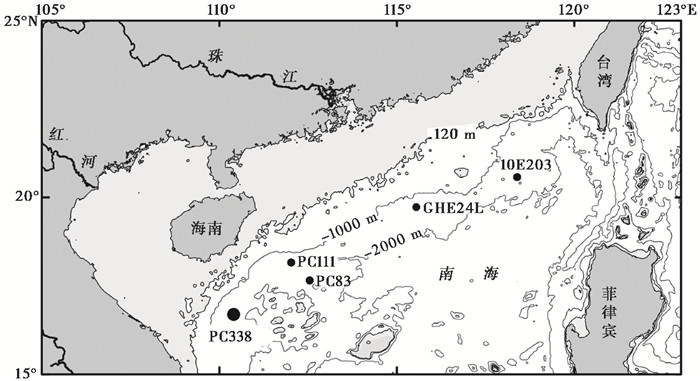
|
图 1 PC338钻孔及本文引用其他钻孔地理位置 Fig. 1 Geographic positions of the core PC338 and other cores referred in this paper |
磁学参数变化对古气候响应的差异,一方面是由不同区域的物源、洋流等差异造成的;另一方面是因为磁学参数所反映的是复合而非单一的古环境信息[20, 22~28]。利用数学方法分离出不同的磁性组分,可有效提取与陆地风化、海洋自生作用、物源变化等古气候相关的信息[29]。在海洋沉积物中,碎屑成因的磁铁矿含量代表河流输入的陆源风化组分,其含量可代表地表风化强度;而赤铁矿与粉尘输入、成壤作用、大陆架的暴露氧化等均有关联[30]。另外,顺磁组分主要是地表风化形成的硅酸盐和粘土矿物[31],亦可反映地表风化程度。
最近,我们对南海西北部陆坡PC338岩芯(图 1)的研究表明,该岩芯的主要载磁性矿物为磁铁矿和赤铁矿,并发现H1时期的磁性矿物含量增大、沉积物变粗[32]。为进一步认识磁性矿物的变化机制,本研究在已发表的磁学和沉积物粒度数据的基础上[32~33],通过进一步的测试并计算不同磁性组分的含量(包括磁铁矿、赤铁矿和顺磁性组分),识别不同组分对H1事件的响应及古环境指示意义。
1 材料与方法PC338岩芯是由广州海洋地质调查局“海洋四号”考察船于2007年7月利用重力活塞取样器在南海西北陆坡的琼东南盆地北部陆坡处钻取的(图 1)。取样点的水深1349 m,经、纬度分别为16°42′N、110°24′E。Sr-Nd同位素对比表明,该区沉积物的主要物源区为红河[16]。该岩芯全长5.96 m,大部分层位的岩性为粘土质粉砂(图 2)。对11件有孔虫壳体和1件植物碎屑的AMS 14C定年表明,该岩芯底部年龄为36 ka B. P.[32](图 2)。按照岩性特征,整个岩芯可划分为5层(A~E)。其中,3.8~4.4 m层位(D层)的粒度明显变粗、颜色明显加深,且存在大量有孔虫壳体和植物碎屑(图 2)。通过详细的粒度测试、沉积学分析、AMS 14C定年,已确定3.8~4.4 m层是发生在末次冰盛期(LGM)的浊流沉积(图 2)[32],并推测由于在LGM时的南海海平面降低了120~130 m[34],红河河口向陆坡方向推进,河口沉积物的卸载及搬运形成了浊流(图 1)。本文选取顶部连续沉积的370 cm段(A~C层),对应20.5 ka B. P.以来的气候变化记录。
从岩芯顶部0~370 cm沉积层中每隔10 cm取厚2 cm的1个样品,并在H1事件层(218 cm、214 cm和206 cm)加取3个样品,共计取41个样品。样品自然晾干后,装入测样用的胶囊中,并称重。然后,利用VSM 3900震动磁强仪依次测试样品的磁滞回线(± 1 T)、等温剩磁(IRM)获得曲线(0~1 T)及反向直流场退磁曲线(0~200 mT),并选取其中20个样品测试一阶反转曲线(FORC)。利用仪器测试软件MicroMag VSM,对磁滞回线进行70%的顺磁校正,导出的饱和磁化强度(Ms)、饱和剩磁(Mrs)、矫顽力(Bc)这3个参数,并利用反向直流场退磁曲线获得剩磁矫顽力(Bcr)。上述4个参数用于绘制判断磁畴状态的Day图。
IRM获得曲线的累积对数高斯(CLG)模型是一种有效计算不同磁性矿物组分的数学方法[35],被广泛用于分离土壤和沉积物的不同矫顽力的磁性矿物组分(如,磁铁矿、赤铁矿、针铁矿等)[35~41]。Robertson和France[38]最早发现,天然磁性矿物样品IRM获得值与外加磁场之间基本符合累积对数高斯(CLG)函数(图 3a),即IRM获得曲线的梯度值(斜率)与外加磁场的关系基本符合对数高斯分布(或称“对数正态分布”)(图 3b)。为定量描述线性获得曲线图(LAP)和获得曲线图的梯度值(GAP),Robertson和France[38]定义了中值矫顽力(B1/2)和分布参数(DP)。B1/2代表呈对数正态分布的每个组分的中值矫顽力大小,与天然磁性矿物的剩磁矫顽力(Bcr)接近;DP是对数正态分布的1个标准差值,表示磁性组分分布的宽窄程度(图 3b)。一般情况下,B1/2为几十mT、几百mT、几千mT,分别代表磁铁矿、赤铁矿和针铁矿;生物成因磁性矿物组分较窄(DP<0.2),碎屑成因磁性矿物的DP较大[35~40]。Kruiver等[39]通过将LAP纵轴的线性坐标转换为概率坐标,并用等距标准化的z值代替非等距的累积百分坐标,得到标准化获得曲线图(SAP)。由于单峰分布的IRM获得曲线的SAP可用直线表示(图 3c),因此可初步确定要分离的样品IRM获得曲线是否为一个组分[39](图 3c)。天然样品中含有多个磁性组分,且每个组分均符合上述模型。本文利用Kruiver等[39]开发的Excel程序IRM-CLG 1.0(http://www.geo.uu.nl/~forth/),对测试的41条IRM获得曲线进行组分分离,并根据每个组分的分布情况分组,并鉴别磁性矿物种类及含量。首先根据SAP分布形态,确定是否为一个或多个组分,再将组分数量往上逐渐调整。另外,对每个组分的SIRM、B1/2和DP赋值,并逐步微调,获得最贴合LAP、GAP、SAP共3条原始数据的总拟合曲线。

|
图 3 IRM获得曲线及其相关的转换曲线[39] (a)线性获得曲线图(LAP);(b)获得曲线图的梯度值(GAP);(c)标准化获得曲线图(SAP) Fig. 3 IRM acquisition curve and the related transformation curves[39]. (a)Linear acquisition plot(LAP), (b)gradient of acquisition plot(GAP) and (c)standardised acquisition plot(SAP) |
高场磁化率主要是由样品中的顺磁性矿物产生的,因此又称“顺磁磁化率”[31, 42]。通常,将原始的磁滞回线在高场(800~1000 mT)下的斜率视为高场磁化率,可用来反映顺磁性组分的含量[31, 42]。为消除不同样品的质量影响,本研究利用该斜率值除以所测试胶囊样品的质量,得到质量归一化的顺磁磁化率(χp,单位:m3/kg)。
2 结果与讨论 2.1 磁滞特征及组分分离结果不同时期样品的IRM获得曲线的形态明显不同,表明不同矫顽力组分贡献的变化(图 4)。Bølling-Allerød(B/A)暖期及全新世样品的IRM获得曲线,在100 mT以上呈现略微上升的趋势;而末次冰盛期和H1时期样品的IRM获得曲线,在100 mT以上仍有大幅度上升的趋势(图 4a、4d、4g和4i)。这说明,末次冰盛期和H1事件时期,沉积物中含有更多的高矫顽力的磁性组分。
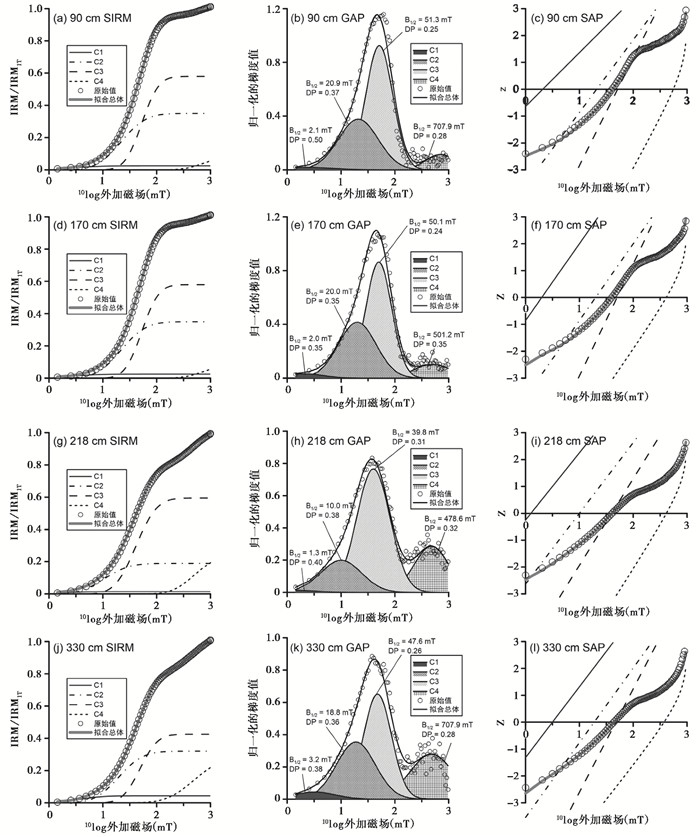
|
图 4 CLG组分分离结果 90 cm和170 cm的样品分别对应于全新世和B/A暖期,218 cm和330 cm的样品分别对应于H1和末次冰盛期(LGM) Fig. 4 The CLG unmixing results. Samples at depths of 90 cm and 170 cm respectively correspond to the Holocene and B/A warming period, while samples with the depths of 218 cm and 330 cm represent the H1 and Last Glacial Maximum, respectively |
CLG分离结果表明,所有样品的IRM获得曲线均可被分解为4个组分(C1~C4)(图 4)。4个组分之和的LAP、GAP和SAP曲线值与原始数据点基本重合,表明结果能很好地拟合IRM获得曲线的组分。CLG分解的各组分用B1/2、DP、剩磁的贡献率和含量来表示。C1的B1/2为1.26~6.31 mT,DP为0.20~1.00,剩磁贡献率为0.94%~4.93%,剩磁含量为0.02×10-3~0.14×10-3 Am2/kg。C1是一个矫顽力和贡献率都极小的组分,通常认为是热弛豫引起的一个虚假组分,不具有现实意义[43]。C2的B1/2为10.00~21.88 mT,DP为0.30~0.38,剩磁贡献率为11.98%~36.10%,剩磁含量为0.31×10-3~1.33×10-3 Am2/kg。C3的B1/2为39.81~56.23 mT,DP为0.24~0.31,剩磁贡献率为40.00%~79.84%,剩磁含量为0.83×10-3~2.16×10-3 Am2/kg。C2和C3两个组分的B1/2均为几十mT且DP>0.2,表明这两个组分均有相对较宽的分布,是典型的碎屑成因的磁铁矿[36~37, 40~41]。C4是矫顽力最高的组分,B1/2为398.11~707.95 mT,DP为0.25~0.45,剩磁贡献率为4.00%~26.22%,剩磁含量为0.09×10-3~0.66×10-3 Am2/kg。这种高矫顽力组分是典型的赤铁矿组分,也与该岩芯样品的热磁曲线结果一致[32]。因此,利用C2和C3的剩磁含量之和(IRM_ (C2+C3))指示陆源输入的磁铁矿含量,而IRM_ C4代表赤铁矿含量。
Day图能用来反映磁性矿物的磁畴状态[44~46]。图 5显示,尽管几乎所有样品处于Day图的假单畴(PSD)区间内,但样品的分布范围较大,表明不同层位的磁性颗粒的粒度有明显变化。H1事件层底部样品的更接近多畴(MD)区域。FORC图沿Bc轴展布代表非相互作用的细颗粒的单畴(SD)信号,而沿Bu轴展布则代表PSD及MD的信号[44]。FORC图显示,H1事件层底部样品在两个轴上均有展布,而其他样品主要沿着Bc轴展布(图 5)。这表明,H1事件发生时,岩芯沉积物的磁性颗粒明显变粗。
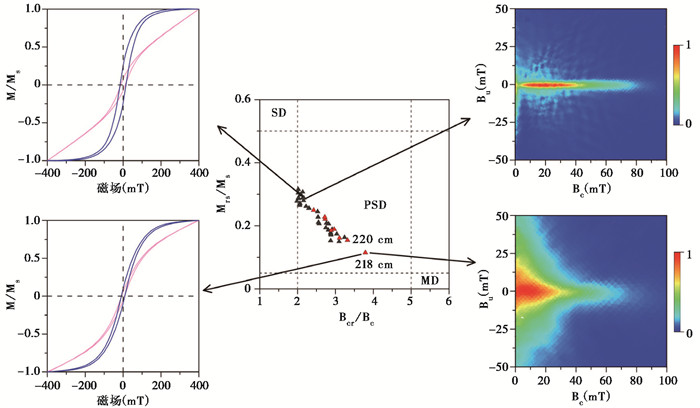
|
图 5 代表性样品的磁滞回线、Day图与FORC图 Day图中,红色三角形代表H1事件的样品,220 cm和218 cm样品取自H1事件层最底部 Fig. 5 Hysteresis loops, Day plots and FORCs for representative samples. In the Day plot, the red triangle represents the sample during the H1 event, and the 220 cm and 218 cm sample locates at the bottom of the H1 event layer |
在约20 ka B. P.以来,磁学参数对末次冰盛期、H1事件、B/A暖期、新仙女木事件以及全新世气候适宜期等标志性的气候事件/阶段,均有显著响应(图 6)。在末次冰盛期(约20.0~18.5 ka B. P.),顺磁磁化率χp和IRM_(C2+C3)值较低,IRM_C4较高,磁性矿物总含量较高、沉积物较粗(图 6)。这表明,在海平面最低、沉积速率最高的时期,更多的赤铁矿随着粗粒沉积物搬运而来,而磁铁矿及顺磁性矿物的降低对应当时冷干的气候条件。χp和IRM_(C2+C3)在约17.3 ka B. P.突然降低,直至15 ka B. P.才呈现上升趋势。同时,χARM/χlf值降低,χlf值和平均粒径(Mz)均增大,表明沉积物粒度和磁性颗粒均变粗、磁性矿物输入量增多(图 6)。这与华南石笋记录的H1事件时期基本一致[7, 47](图 6a),因此这个阶段是南海沉积物对H1气候突变事件的响应。H1事件以后,χp和IRM_(C2+C3)值在约15~6 ka B. P.内增大,并在约11~12 ka B. P.降低。χp、IRM_(C2+C3)与华南石笋记录的东亚夏季风强度的变化[7, 47]几乎完全一致(图 6a~6c)。这些指示东亚夏季风强度的参数与北纬30°夏季日照辐射量[48]基本一致,表明日照辐射对区域夏季风强度的驱动(图 6a~6d)。χp和IRM_(C2+C3)对H1响应非常明显,而在末次冰盛期和新仙女木时期的变化很小。这可能是因为H1是这3个事件里最为冷干的事件,气候变化最为显著。20.5 ka B. P.至7 ka B. P.期间,全球和区域海平面呈逐渐上升的趋势[49~53]。新仙女木时期的海平面比H1时期已经上升40~50 m[49~52](图 6l)。因此,新仙女木时期的PC338站位置与红河口的距离更远,陆源碎屑的输入量大大降低,沉积水动力条件发生改变,这可能也对磁性矿物的搬运造成影响(图 6)。
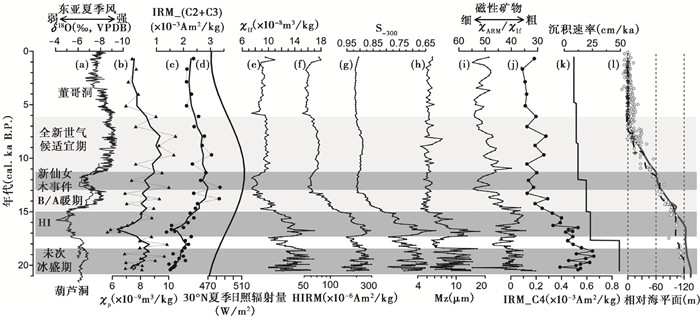
|
图 6 PC338的磁学参数变化及古气候时代划分 (a)董哥洞[47]和葫芦洞[7]石笋δ18O值;(b)χp;(c)IRM_(C2+C3);(d)北纬30°夏季日照辐射量[48];(e~i)环境磁学和粒度参数[32];(j) IRM_C4;(k)沉积速率[32];(l)区域和全球相对海平面,其中,虚线代表中国东部海域[49]、三角形代表巽他陆架[50]、圆点[51]和实线[52]代表全球相对海平面高度、十字架代表粤西沿岸[53];(b)和(c)中的粗线为5点平滑的数值 Fig. 6 Down-core variations in magnetic parameters and the division of paleoclimate periods. (a)Stalagmite δ18O of Dongge[47] and Hulu[7] caves, (b)χp, (c)IRM_(C2+C3), (d)the 30°N insolation[48], (e~i)environmental magnetic and grain-size parameters[32], (j)IRM_C4, (k)deposition rate[32], (l)regional and global relative sea level. In (l), dot line and triangle represent relative sea levels(RSLs)of East China seas[49] and Sunda continental shelf[50], respectively. Solid dot[51] and line[52] denote the global RSL. The crosses mark the RSL of Western Guangdong coasts[53]. Bold lines in (b) and (c) denote the values with five-point linear smoothing |
H1事件发生时,PC338岩芯的χp、IRM_(C2+C3)都明显降低(图 6b和6c),这表明地表风化产生的顺磁性组分和磁铁矿含量均有较大幅度降低。H1事件期间冷水种的有孔虫含量增多[12],热带和亚热带孢粉含量降低[54],这表明该时期南海北部及华南大陆呈现寒冷干燥的气候。顺磁性组分和磁铁矿含量的降低,应是对华南冷干的气候条件的响应[7, 47]。然而,赤铁矿的绝对含量(HIRM、IRM_C4)和相对含量(S- 300)都较高,且与粒径参数χARM/χlf的变化一致(图 6e~6j)。这种变化,可能与以下3个因素有关:1)源区红河含大量赤铁矿[55~56],且赤铁矿在大陆架富集在粗颗粒沉积物中,末次冰盛期至H1时期的全球海平面较低(图 6l)[49~52],近距离搬运的沉积物较粗,因此大量赤铁矿随之沉积在陆坡;2)H1时期南海西北部大陆架的大部分区域被暴露,整个大陆架处于氧化状态,含铁矿物被氧化成赤铁矿;3)在极端干冷的H1事件时期,粉尘也输入了更多的赤铁矿[22]。
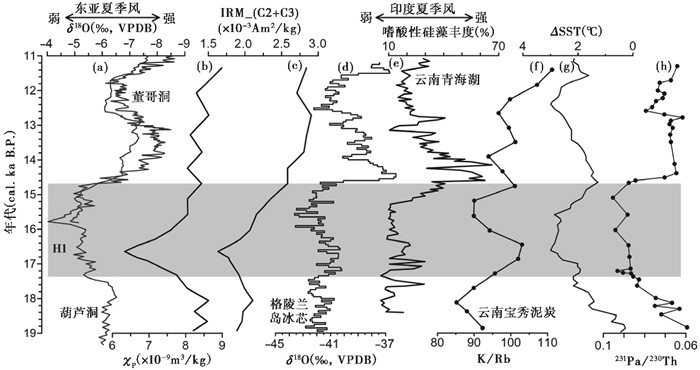
|
图 7 19~11 ka B. P.间不同区域的古气候指标对比 (a)董哥洞[47]和葫芦洞[7]石笋δ18O值;(b)5点平滑的χp;(c)5点平滑的IRM_(C2+C3);(d)格陵兰岛冰芯δ18O值(GISP2)[62];(e)云南青海湖嗜酸性硅藻丰度[65];(f)云南宝秀泥炭K/Rb值[66];(g)热带太平洋东、西部的表层海水表层温度差(ΔSST)[68~69];(h)北大西洋231 Pa/230 Th[70] Fig. 7 Comparison of paleoclimate indexes in different areas during 19~11 ka B. P. (a)Stalagmite δ18O of Dongge[47] and Hulu caves[7], (b)χp with five-point linear smoothing, (c)IRM_(C2+C3)with five-point linear smoothing, (d)δ18O record of the Greenland ice core(GISP2)[62], (e)abundance of acidophilous diatom of the Qinghai Lake, Yunnan[65], (f)K/Rb of Baoxiu peat, Yunnan[66], (g)sea surface temperature difference between the east and west parts of the Pacific[68~69], and (h) North Atlantic Ocean 231 Pa/230 Th[70] |
PC338的磁性颗粒在H1时期略微变粗(图 6h),这与GHE24L的结果相反[26]。末次冰盛期至H1海平面比现代低130~100 m[49~53](图 6l),河口至PC338站位距离大大缩短,因此磁性颗粒变粗(图 1和图 6h以及6i)。南海深层水的主要流向为西沙群岛以东的深海盆[57]。数值模拟显示,深层水向南海西北部陆坡运移的流速极低[58],对沉积物运移的影响很小。磁性矿物的粒度与海平面和沉积速率变化趋势一致(图 6i、6k和6l),表明本区磁性颗粒粒度的主要控制因素是海平面,与南海东北部的河口水动力条件变化[26]或深层水侵入[27]的机制不同。
传统观点认为,H1事件是由大西洋经向翻转环流(Atlantic Meridional Overturning Circulation,简称AMOC)的减弱导致的,即当时大量的淡水涌入北大西洋,在很大程度上削弱了AMOC,因此在北半球高纬度地区触发了突然冷干的H1事件[59]。另外,北大西洋变冷会导致大西洋和太平洋地区热带辐合带(Intertropical Convergence Zone,简称ITCZ)的南移,并因此削弱了亚洲季风的强度[60~61]。然而,H1事件期间,仅北太平洋及部分边缘海(包括南海)的表层海水温度明显降低,热带-亚热带太平洋海域的持续温暖条件未受影响[9]。华南石笋氧同位素[7, 47]及本研究记录的东亚夏季风在H1期间呈明显的突变趋势,且其变化幅度比格陵兰岛冰芯的氧同位素[62]更大(图 7a~7d)。这表明,这个全球性的突变气候事件在东亚季风区的响应尤为明显。假如AMOC在H1期间的减弱迫使ITCZ南移,那么南半球会明显变湿,且印度季风应与东亚季风应基本同步变化[63];然而,在H1期间,南半球只有非洲南部的少部分区域变湿[64]。H1事件对东亚季风区和印度季风区的影响也明显不同。H1事件是东亚季风区的一大“灾难性气候事件”,是末次冰消期最干旱的时期[63]。而印度季风区对H1事件虽有响应,但其气候变化程度远不如东亚季风区。云南青海湖嗜酸性硅藻丰度[65]及宝秀泥炭的K/Rb[66]是记录印度季风演化的有效指标。H1的两个参数值并不是末次冰消期(19~11 ka B. P.)的最低值(图 7e和7f),表明H1并非印度季风区末次冰消期的最干旱时期。因此,H1事件对亚洲季风区气候变化的影响,不能仅用ITCZ南移来解释[63]。Zhou等[63]认为,除ITCZ南移外,类似La Niña的气候条件对亚洲季风区的干旱化也有作用。在La Niña气候条件下,热带太平洋的东、西部海水表层温差(ΔSST)增大,东亚季风区明显变干[67]。图 7g显示,ΔSST在H1时期为2~3 ℃,明显高于末次冰消期其他时期[68~69],表明类La Niña气候条件对东亚季风区的显著影响。因此,在H1事件期间,AMOC的减弱如北大西洋沉积物的231 Pa/230 Th增大[70](图 7h)和热带太平洋类La Niña气候条件的综合影响,最终导致东亚季风区的极端干旱(图 7)。
3 结论通过对南海西北部琼东南盆地北部陆坡PC338岩芯20.5 ka B. P.以来的磁学性质分析,获得不同磁性组分(磁铁矿、赤铁矿和顺磁性组分)对H1事件的响应,得到如下结论:
(1) 利用CLG方法对IRM获得曲线的分离结果表明,磁性组分可被分解为4个,其中组分1不具有实际意义,组分2与组分3代表不同粒径的陆地碎屑成因磁铁矿,组分4(IRM_C4)代表赤铁矿。组分2与组分3之和(IRM_(C2+C3))与顺磁性磁化率(χp)均受到陆地风化物质的输入控制,可作为东亚夏季风强度的替代指标。
(2) 在H1事件期间,尽管磁性矿物总量(χlf)输入增多,但碎屑成因的磁铁矿输入量(IRM_(C2+C3))和顺磁性组分含量都明显降低。这表明,H1时期南海北部地区的陆地风化强度减弱,与华南石笋记录的冷干气候条件一致。
(3) 赤铁矿的含量(IRM_C4,HIRM)在H1事件期间明显增多,可能与海平面降低,大陆架物源区暴露造成的地表氧化、粗粒沉积物的大量输入等有关。
(4) 综合对比发现,H1事件时期,东亚季风区呈现极端干旱的气候特征,而印度季风区并非末次冰消期中最干旱的时期。除了AMOC的减弱迫使ITCZ南移这一因素以外,热带太平洋海域类La Niña的气候条件也可能导致了东亚季风区的干旱化加剧。
致谢: 感谢中国科学院广州地球化学研究所胡建芳研究员的邀稿!感谢审稿专家和杨美芳编辑宝贵的修改意见!
| [1] |
Heinrich H. Origin and consequences of cyclic ice rafting in the northeast Atlantic Ocean during the past 130, 000 years[J]. Quaternary Research, 1988, 29(2): 142-152. DOI:10.1016/0033-5894(88)90057-9 |
| [2] |
Bond G, Heinrich H, Broecker W, et al. Evidence for massive discharges of icebergs into the North Atlantic ocean during the last glacial period[J]. Nature, 1992, 360(6401): 245-249. DOI:10.1038/360245a0 |
| [3] |
Grimm E, Jacobson G L, Watts W A, et al. A 50, 000-year record of climate oscillations from Florida and its temporal correlation with the Heinrich Events[J]. Science, 1993, 261(5118): 198-200. DOI:10.1126/science.261.5118.198 |
| [4] |
Porter S, An Z. Correlation between climate events in the North Atlantic and China during the last glaciation[J]. Nature, 1995, 375(6529): 305-308. DOI:10.1038/375305a0 |
| [5] |
孙有斌, 郭飞. 中国黄土记录的季风快速变化[J]. 第四纪研究, 2017, 37(5): 963-973. Sun Youbin, Guo Fei. Rapid monsoon changes recorded by Chinese loess deposits[J]. Quaternary Sciences, 2017, 37(5): 963-973. |
| [6] |
吴吉春, 盛煜, 赵林, 等. 柴达木盆地中的砂楔及其意义[J]. 第四纪研究, 2018, 38(1): 86-96. Wu Jichun, Sheng Yu, Zhao Lin, et al. Characteristics and implication of sand-wedges in Qaidam Basin, northeast Qinghai-Tibetan Plateau[J]. Quaternary Sciences, 2018, 38(1): 86-96. |
| [7] |
Wang Y J, Cheng H, Edwards R L, et al. A high-resolution absolute-dated Late Pleistocene monsoon record from Hulu Cave, China[J]. Science, 2001, 294(5550): 2345-2348. DOI:10.1126/science.1064618 |
| [8] |
崔梦月, 肖海燕, 孙晓双, 等. 福建仙云洞石笋记录的Heinrich 1事件突变特征[J]. 科学通报, 2017, 62(26): 3078-3088. Cui Mengyue, Xiao Haiyan, Sun Xiaoshuang, et al. Characteristics of the Heinrich 1 abrupt climate event inferred from a speleothem record from Xianyun Cave, Fujian Province[J]. Chinese Science Bulletin, 2017, 62(26): 3078-3088. |
| [9] |
Kiefer T, Kienast M. Patterns of deglacial warming in the Pacific Ocean:A review with emphasis on the time interval of Heinrich event 1[J]. Quaternary Science Reviews, 2005, 24(7-9): 1063-1081. DOI:10.1016/j.quascirev.2004.02.021 |
| [10] |
汪品先. 南海——我国深海研究的突破口[J]. 热带海洋学报, 2009, 28(3): 1-4. Wang Pinxian. Towards scientific breakthrough in the South China Sea[J]. Journal of Tropical Oceanography, 2009, 28(3): 1-4. DOI:10.3969/j.issn.1009-5470.2009.03.001 |
| [11] |
杨策, 徐建, 张鹏, 等. 27万年来南海南部上部水体结构和古生产力变化的古海洋学记录[J]. 第四纪研究, 2017, 37(3): 452-462. Yang Ce, Xu Jian, Zhang Peng, et al. Paleoceanographic records of upper ocean water structure and paleoproductivity in the southern South China Sea since 270 ka[J]. Quaternary Sciences, 2017, 37(3): 452-462. |
| [12] |
Chen M, Wang C, Huang C, et al. A Late Quaternary planktonic foraminifer faunal record of rapid climatic changes from the South China Sea[J]. Marine Geology, 1999, 156(1-4): 85-108. DOI:10.1016/S0025-3227(98)00174-1 |
| [13] |
葛倩, 孟宪伟, 初凤友, 等. 南海北部ZHS-176孔古海洋学记录:氧同位素和有机碳[J]. 海洋地质与第四纪地质, 2012, 32(5): 73-80. Ge Qian, Meng Xianwei, Chu Fengyou, et al. Paleoceanographic records of core ZHS-176 from the Northern South China Sea:Oxygen isotope and organic carbon[J]. Marine Geology & Quaternary Geology, 2012, 32(5): 73-80. |
| [14] |
Xiang R, Chen M, Li Q, et al. Planktonic foraminiferal records of East Asia monsoon changes in the southern South China Sea during the last 40, 000 years[J]. Marine Micropaleontology, 2009, 73(1-2): 1-13. DOI:10.1016/j.marmicro.2009.06.004 |
| [15] |
Huang J, Jiang F, Wan S, et al. Terrigenous supplies variability over the past 22, 000 yr in the southern South China Sea slope:Relation to sea level and monsoon rainfall changes[J]. Journal of Asian Earth Sciences, 2016, 117: 317-327. DOI:10.0.3.248/j.jseaes.2015.12.019 |
| [16] |
Wan S, Toucanne S, Clift P, et al. Human impact overwhelms long-term climate control of weathering and erosion in Southwest China[J]. Geology, 2015, 43(5): 439-442. DOI:10.1130/G36570.1 |
| [17] |
沈吉, 肖霞云. 2万年来南亚季风演化历史[J]. 第四纪研究, 2018, 38(4): 799-820. Shen Ji, Xiao Xiayun. Evolution of the South Asian Monsoon during the last 20 ka recorded in lacustrine sediments from Southwestern China[J]. Quaternary Sciences, 2018, 38(4): 799-820. |
| [18] |
张恩楼, 孙伟伟, 刘恩峰, 等. 末次冰盛期以来洱海沉积物元素碳同位素特征与区域植被组成变化[J]. 第四纪研究, 2017, 37(5): 1027-1036. Zhang Enlou, Sun Weiwei, Liu Enfeng, et al. Vegetation change reconstructed by a stable isotope record of elemental carbon from Lake Erhai, Southwest China since the Last Glacial Maximum[J]. Quaternary Sciences, 2017, 37(5): 1027-1036. |
| [19] |
Robinson S. The Late Pleistocene palaeoclimatic record of North Atlantic deep-sea sediments revealed by mineral-magnetic measurements[J]. Physics of the Earth and Planetary Interiors, 1986, 42(1): 22-47. |
| [20] |
Kissel C, Laj C, Clemens S, et al. Magnetic signature of environmental changes in the last 1.2 Myr at ODP Site 1146, South China Sea[J]. Marine Geology, 2003, 20(1-3): 119-132. |
| [21] |
侯红明, 王保贵, 汤贤赞. 南海北部沉积物磁化率对古气候非线性变化的响应[J]. 热带海洋, 1996, 15(3): 1-5. Hou Hongming, Wang Baogui, Tang Xianzan. A response to paleoclimatic nonlinear variations from sediment magnetic susceptibility in northern South China Sea[J]. Tropical Oceanology, 1996, 15(3): 1-5. |
| [22] |
Chen Q, Kissel C, Liu Z. Late Quaternary climatic forcing on the terrigenous supply in the northern South China Sea:Input from magnetic studies[J]. Earth and Planetary Science Letters, 2017, 471: 160-171. DOI:10.1016/j.epsl.2017.04.047 |
| [23] |
Ouyang T, Li M, Zhao X, et al. Sensitivity of sediment magnetic records to climate change during Holocene for the northern South China Sea[J]. Frontiers in Earth Science, 2016, 4: 1-12. DOI:10.3389/feart.2016.00054 |
| [24] |
张江勇, 高红芳, 彭学超, 等. 南海陆坡晚第四纪沉积物磁化率的对比及其古海洋学意义[J]. 海洋地质与第四纪地质, 2010, 30(4): 156-164. Zhang Jiangyong, Gao Hongfang, Peng Xuechao, et al. Comparison of magnetic susceptibility of Late Quaternary sediment derived from slopes in the South China Sea and implication for paleoceanography[J]. Marine Geology & Quaternary Geology, 2010, 30(4): 151-164. |
| [25] |
杨小强, 李华梅, 周永章. 南海南部NS93-5孔沉积物磁化率特征及其对全球气候变化的记录[J]. 海洋地质与第四纪地质, 2002, 22(1): 31-36. Yang Xiaoqiang, Li Huamei, Zhou Yongzhang. Magnetic susceptibility oscillation and unstable climate of core NS93-5 from South China Sea[J]. Marine Geology & Quaternary Geology, 2002, 22(1): 31-36. |
| [26] |
王世朋, 李永祥, 付少英, 等. 南海北部陆坡GHE24L柱样沉积物磁性特征及其环境意义[J]. 第四纪研究, 2014, 34(3): 516-527. Wang Shipeng, Li Yongxiang, Fu Shaoying, et al. Environmental changes as recorded by mineral magnetic properties of sediments from the core GHE24L, South China Sea[J]. Quaternary Sciences, 2014, 34(3): 516-527. DOI:10.3969/j.issn.1001-7410.2014.03.06 |
| [27] |
Zheng X, Kao S, Chen Z, et al. Deepwater circulation variation in the South China Sea since the Last Glacial Maximum[J]. Geophysical Research Letters, 2016, 43(16): 8590-8599. DOI:10.1002/2016GL070342 |
| [28] |
Li N, Yang X, Peng J, et al. Deep-water bottom current evolution in the northern South China Sea during the last 150 kyr:Evidence from sortable-silt grain size and sedimentary magnetic fabric[J]. Journal of Asian Earth Sciences, 2019, 171: 78-87. DOI:10.1016/j.jseaes.2017.06.005 |
| [29] |
Heslop D. Numerical strategies for magnetic mineral unmixing[J]. Earth-Science Reviews, 2015, 150: 256-284. DOI:10.1016/j.earscirev.2015.07.007 |
| [30] |
Liu Q, Roberts A P, Larrasoana J C, et al. Environmental magnetism:Principles and applications[J]. Reviews of Geophysics, 2012, 50(4): RG4002. |
| [31] |
Zhang Q, Liu Q, Li J, et al. An integrated study of the eolian dust in pelagic sediments from the North Pacific Ocean based on environmental magnetism, transmission electron microscopy, and diffuse reflectance spectroscopy[J]. Journal of Geophysical Research:Solid Earth, 2018, 123(5): 3358-3376. DOI:10.1002/2017JB014951 |
| [32] |
Li M, Ouyang T, Roberts A, et al. Influence of sea level change and centennial East Asian monsoon variations on northern South China Sea sediments over the past 36 kyr[J]. Geochemistry, Geophysics, Geosystems, 2018, 19(5): 1674-1689. DOI:10.1029/2017GC007321 |
| [33] |
Li M, Ouyang T, Tian C, et al. Sedimentary responses to the East Asian monsoon and sea level variations recorded in the northern South China Sea over the past 36 kyr[J]. Journal of Asian Earth Sciences, 2019, 171: 213-229. DOI:10.1016/j.jseaes.2018.01.001 |
| [34] |
Wang P, Sun X. Last Glacial Maximum in China:Comparison between land and sea[J]. Catena, 1994, 23(3-4): 341-353. DOI:10.1016/0341-8162(94)90077-9 |
| [35] |
Heslop D, Dekkers M, Kruiver P, et al. Analysis of isothermal remanent magnetization acquisition curves using the Expectation-Maximization Algorithm[J]. Geophysical Journal International, 2002, 148(1): 58-64. DOI:10.1046/j.0956-540x.2001.01558.x |
| [36] |
王喜生, 李学军. 等温剩磁获得曲线的累积对数高斯模型在泥河湾盆地磁组分识别中的运用[J]. 地学前缘, 2003, 10(1): 163-169. Wang Xisheng, Li Xuejun. Identification of remanence-carrying minerals of Nihewan samples, using the modeling of isothermal remanent magnetization acquisition curves by Cumulative Log Gaussian functions[J]. Earth Science Frontiers, 2003, 10(1): 163-169. DOI:10.3321/j.issn:1005-2321.2003.01.019 |
| [37] |
Ouyang T, Tang Z, Zhao X, et al. Magnetic mineralogy of a weathered tropical basalt, Hainan Island, South China[J]. Physics of the Earth and Planetary Interiors, 2015, 240: 105-113. DOI:10.1016/j.pepi.2015.01.001 |
| [38] |
Robertson D J, France D E. Discrimination of remanence-carrying minerals in mixtures, using isothermal remanent magnetisation acquisition curves[J]. Physics of the Earth and Planetary Interiors, 1994, 82(3-4): 223-234. DOI:10.1016/0031-9201(94)90074-4 |
| [39] |
Kruiver P P, Dekkers M J, Heslop D. Quantification of magnetic coercivity components by the analysis of acquisition curves of isothermal remanent magnetisation[J]. Earth and Planetary Science Letters, 2001, 189(3-4): 269-276. DOI:10.1016/S0012-821X(01)00367-3 |
| [40] |
Abrajevitch A, Font E, Florindo F, et al. Asteroid impact vs. Deccan eruptions:The origin of low magnetic susceptibility beds below the Cretaceous-Paleogene boundary revisited[J]. Earth and Planetary Science Letters, 2015, 430: 209-223. DOI:10.1016/j.epsl.2015.08.022 |
| [41] |
Roberts A, Florindo F, Chang L, et al. Magnetic properties of pelagic marine carbonates[J]. Earth-Science Reviews, 2013, 127: 111-139. DOI:10.1016/j.earscirev.2013.09.009 |
| [42] |
Ao H, Deng C, Dekkers M, et al. Magnetic mineral dissolution in Pleistocene fluvio-lacustrine sediments, Nihewan Basin(North China)[J]. Earth and Planetary Science Letters, 2010, 292(1-2): 191-200. DOI:10.1016/j.epsl.2010.01.035 |
| [43] |
Heslop D, McIntosh G, Dekkers M J. Using time-and temperature-dependent Preisach models to investigate the limitations of modelling isothermal remanent magnetization acquisition curves with cumulative log Gaussian functions[J]. Geophysical Journal International, 2004, 157(1): 55-63. DOI:10.1111/gji.2004.157.issue-1 |
| [44] |
Roberts A, Pike C, Verosub K. First-order reversal curve diagrams:A new tool for characterizing the magnetic properties of natural samples[J]. Journal of Geophysical Research, 2000, 105(B12): 28461-28475. DOI:10.1029/2000JB900326 |
| [45] |
陈曦, 葛淑兰, 刘建兴, 等. IODP 341航次之阿拉斯加湾U1417站位磁性地层学研究[J]. 第四纪研究, 2017, 37(6): 1334-1347. Chen Xi, Ge Shulan, Liu Jianxing, et al. Magnetostratigraphy of IODP Expedition 341 Site U1417 in the Gulf of Alaska[J]. Quaternary Sciences, 2017, 37(6): 1334-1347. |
| [46] |
王荣华, 郭雪莲, 蒲宗文. 兰州九州台"上粉砂层"黄土L9的剩磁记录特征研究[J]. 第四纪研究, 2016, 36(5): 1139-1153. Wang Ronghua, Guo Xuelian, Pu Zongwen. The paleomagnetic records of the upper sandy loess L9 in Jiuzhoutai section, Lanzhou[J]. Quaternary Sciences, 2016, 36(5): 1139-1153. |
| [47] |
Dykoski C, Edwards R, Cheng H, et al. A high-resolution, absolute-dated Holocene and deglacial Asian monsoon record from Dongge Cave, China[J]. Earth and Planetary Science Letters, 2005, 233(1-2): 71-86. DOI:10.1016/j.epsl.2005.01.036 |
| [48] |
Berger A, Loutre M. Insolation values for the climate of the last 10 million years[J]. Quaternary Science Reviews, 1991, 10(4): 297-317. DOI:10.1016/0277-3791(91)90033-Q |
| [49] |
Liu J, Milliman J, Gao S, et al. Holocene development of the Yellow River's subaqueous delta, North Yellow Sea[J]. Marine Geology, 2004, 209(1-4): 45-67. DOI:10.1016/j.margeo.2004.06.009 |
| [50] |
Hanebuth T, Stattegger K, Grootes P. Rapid flooding of the Sunda Shelf:A late-glacial sea-level record[J]. Science, 2000, 288(5468): 1033-1035. DOI:10.1126/science.288.5468.1033 |
| [51] |
Grant K, Rohling E, Ramsey C, et al. Sea-level variability over five glacial cycles[J]. Nature Communications, 2014, 5: 5076. DOI:10.1038/ncomms6076 |
| [52] |
Lambeck K, Rouby H, Purcell A, et al. Sea level and global ice volumes from the Last Glacial Maximum to the Holocene[J]. Proceedings of the National Academy of Sciences of the United States of America, 2014, 111(43): 15296-15303. DOI:10.1073/pnas.1411762111 |
| [53] |
Zong Y. Mid-Holocene sea-level highstand along the southeast coast of China[J]. Quaternary International, 2004, 117(1): 55-67. DOI:10.1016/S1040-6182(03)00116-2 |
| [54] |
Dai L, Weng C. Marine palynological record for tropical climate variations since the late Last Glacial Maximum in the northern South China Sea[J]. Deep-Sea Research Ⅱ, 2015, 122: 153-162. DOI:10.1016/j.dsr2.2015.06.011 |
| [55] |
田成静.海南岛周边海域表层沉积物地球化学与环境磁学特征及其物源指示意义[D].北京: 中国科学院大学硕士论文, 2014: 45-47. Tian Chengjing. Characteristics of Geochemistry, Environmental Magnetism and Its Provenance Implication of Surface Sediments in the Sea Areas around the Hainan Island[D]. Beijing: The Master's Thesis of University of Chinese Academy of Sciences, 2014: 45-47. http://ir.gig.ac.cn:8080/handle/344008/29144 |
| [56] |
Kissel C, Liu Z, Li J, et al. Magnetic minerals in three Asian rivers draining into the South China Sea:Pearl, Red, and Mekong rivers[J]. Geochemistry, Geophysics, Geosystems, 2016, 17(5): 1678-1693. DOI:10.1002/2016GC006283 |
| [57] |
Shao L, Li X, Geng J, et al. Deep water bottom current deposition in the northern South China Sea[J]. Science in China(Series D:Earth Sciences), 2007, 50(7): 1060-1066. DOI:10.1007/s11430-007-0015-y |
| [58] |
Chen H, Xie X, Zhang W, et al. Deep-water sedimentary systems and their relationship with bottom currents at the intersection of Xisha Trough and Northwest Sub-Basin, South China Sea[J]. Marine Geology, 2016, 378: 101-113. DOI:10.1016/j.margeo.2015.11.002 |
| [59] |
Alley R. Wally was right:Predictive ability of the North Atlantic "Conveyor Belt" hypothesis for abrupt climate change[J]. Earth and Planetary Sciences, 2007, 35(1): 241-272. DOI:10.1146/annurev.earth.35.081006.131524 |
| [60] |
Zhang R, Delworth T. Simulated tropical response to a substantial weakening of the Atlantic Thermohaline Circulation[J]. Journal of Climate, 2005, 18(12): 1853-1860. DOI:10.1175/JCLI3460.1 |
| [61] |
Sun Y, Clemens S, Morrill C, et al. Influence of Atlantic Meridional Overturning Circulation on the East Asian winter monsoon[J]. Nature Geoscience, 2011, 5(1): 46-49. |
| [62] |
Grootes P M, Stuiver M, White J W C, et al. Comparison of oxygen isotope records from the GISP 2 and GRIP Greenland ice cores[J]. Nature, 1993, 366(6455): 552. DOI:10.1038/366552a0 |
| [63] |
Zhou X, Sun L, Chu Y, et al. Catastrophic drought in East Asian monsoon region during Heinrich event 1[J]. Quaternary Science Reviews, 2016, 141: 1-8. DOI:10.1016/j.quascirev.2016.03.029 |
| [64] |
Stager J C, Ryves D B, Chase B M, et al. Catastrophic drought in the Afro-Asian monsoon region during Heinrich Event 1[J]. Science, 2011, 331(6022): 1299-1302. DOI:10.1126/science.1198322 |
| [65] |
Li Y, Chen X, Xiao X, et al. Diatom-based inference of Asian monsoon precipitation from a volcanic lake in Southwest China for the last 18.5 ka[J]. Quaternary Science Reviews, 2018, 182: 109-120. DOI:10.1016/j.quascirev.2017.11.021 |
| [66] |
Huang C, Wei G, Ma J, et al. Evolution of the Indian summer monsoon during the interval 32.7-11.4 cal. ka BP:Evidence from the Baoxiu peat, Yunnan, Southwest China[J]. Journal of Asian Earth Sciences, 2016, 131: 72-80. DOI:10.1016/j.jseaes.2016.09.008 |
| [67] |
Zhang R. Relations of water vapor transport from Indian monsoon with that over East Asia and the summer rainfall in China[J]. Advances in Atmospheric Sciences, 2001, 18(5): 1005-1017. DOI:10.1007/BF03403519 |
| [68] |
Dubois N, Kienast M, Kienast S, et al. Millennial-scale variations in hydrography and biogeochemistry in the Eastern Equatorial Pacific over the last 100 kyr[J]. Quaternary Science Reviews, 2011, 30(1-2): 210-223. DOI:10.1016/j.quascirev.2010.10.012 |
| [69] |
Mohtadi M, Steinke S, Lückge A, et al. Glacial to Holocene surface hydrography of the tropical eastern Indian Ocean[J]. Earth and Planetary Science Letters, 2010, 292(1-2): 89-97. DOI:10.1016/j.epsl.2010.01.024 |
| [70] |
McManus J F, Francois R, Gherardi J M, et al. Collapse and rapid resumption of Atlantic meridional circulation linked to deglacial climate changes[J]. Nature, 2004, 428(6985): 834. DOI:10.1038/nature02494 |
2 Key Laboratory of Ocean and Marginal Sea Geology, Guangzhou Institute of Geochemistry, Chinese Academy of Sciences, Guangzhou 510640, Guangdong;
3 Guangzhou Marine Geological Survey, Guangzhou 510075, Guangdong)
Abstract
The Heinrich 1 (H1) Event is an important millennium paleoclimate event during the last deglaciation. Sediment magnetic properties in different sea areas of the South China Sea (SCS) have different responses to the H1 event, so the multiplicity of magnetic parameters should be noted. In this paper, detailed magnetic properties for the well-dated core PC338 on northwestern SCS continental slope were analyzed to provide a reasonable explanation on the sedimentary magnetic response to the regional climate change. The core was retrived from the northern slope of the Qiongdongnan Basin at the water depth of 1349 m, which latitude and longitude are 16°42'N and 110°24'E, respectively. The core with a length of 5.96 m spans the past 36 ka B. P. A total of 41 samples from the topmost 3.7 m that spanned the past 20.5 ka were chosen for magnetic analyses, including the IRM acquisition curve, back-field direct current demagnetization, hysteresis loop, and first-order reversal curve. The cumulative log-Gaussian (CLG) analysis for IRM acquisition curve indicates magnetic minerals in the core mainly contain detrital magnetite and hematite. The IRM component of terrigenous magnetite and paramagnetic susceptibility (χp) are effective for recording surface weathering, and hematite is controlled by provenance and sea-level in the South China Sea. Results show that during the H1 event, the detrital magnetite (IRM_(C2+C3)) and paramagnetic component (χp) are significantly reduced, which reflects the weakening of chemical weathering in the source area and the cooling climate in the northern SCS. In addition, the hematite content in the northwestern SCS slope was higher over the H1 event, which was related to the hematite input from the Red River caused by the decreased sea level, and the oxidative state under the exposed continental shelf condition. During the H1 event, the climatic characteristics of the extreme drought in the East Asian monsoon region and the weakening of the Atlantic meridional overturning circulation forced the southern convergence of the tropical convergence zone and the climatic conditions of the tropical Pacific La Niña. During the H1 event, the extremely drought climatic characteristics in the East Asian monsoon region were mainly controlled by the weakening of the Atlantic meridional overturning circulation that forced the tropical convergence zone to move southward and the tropical Pacific La Niña climatic condition. 2019, Vol.39
2019, Vol.39

